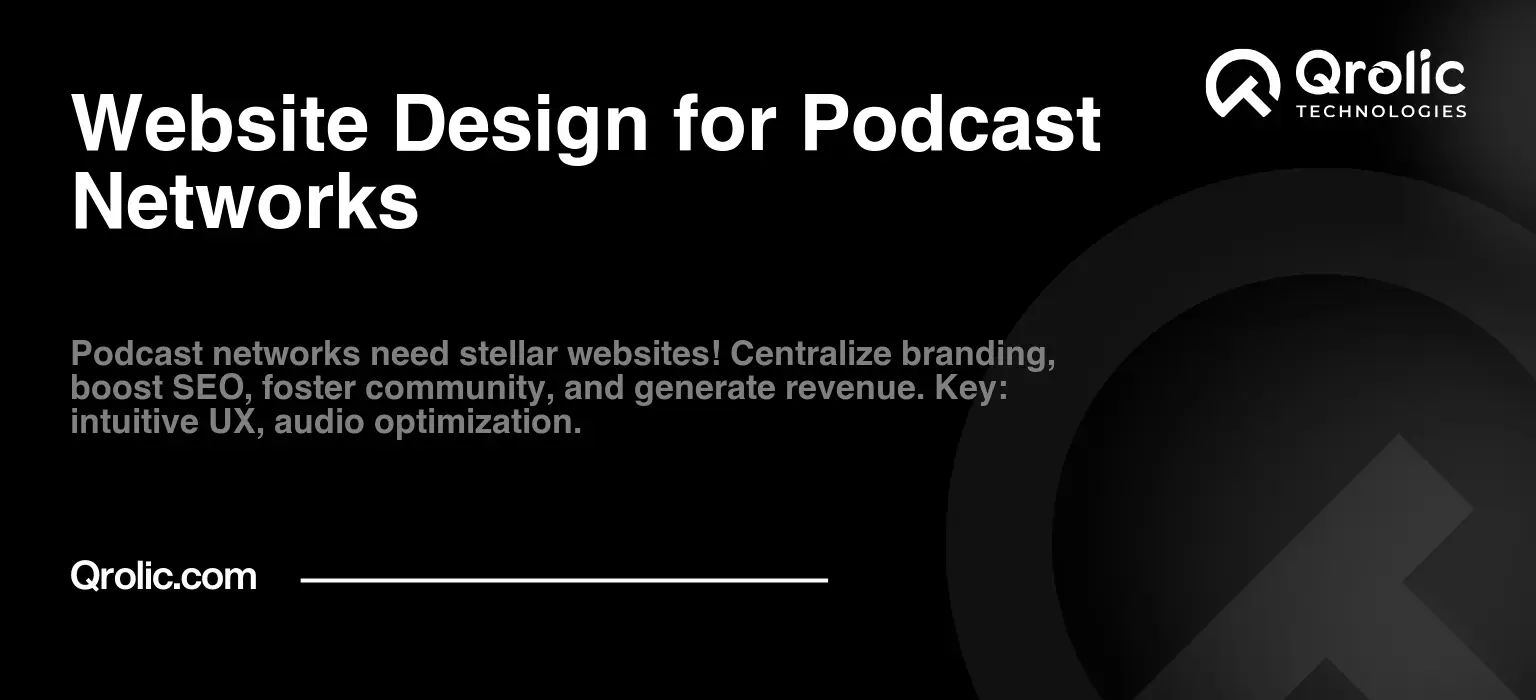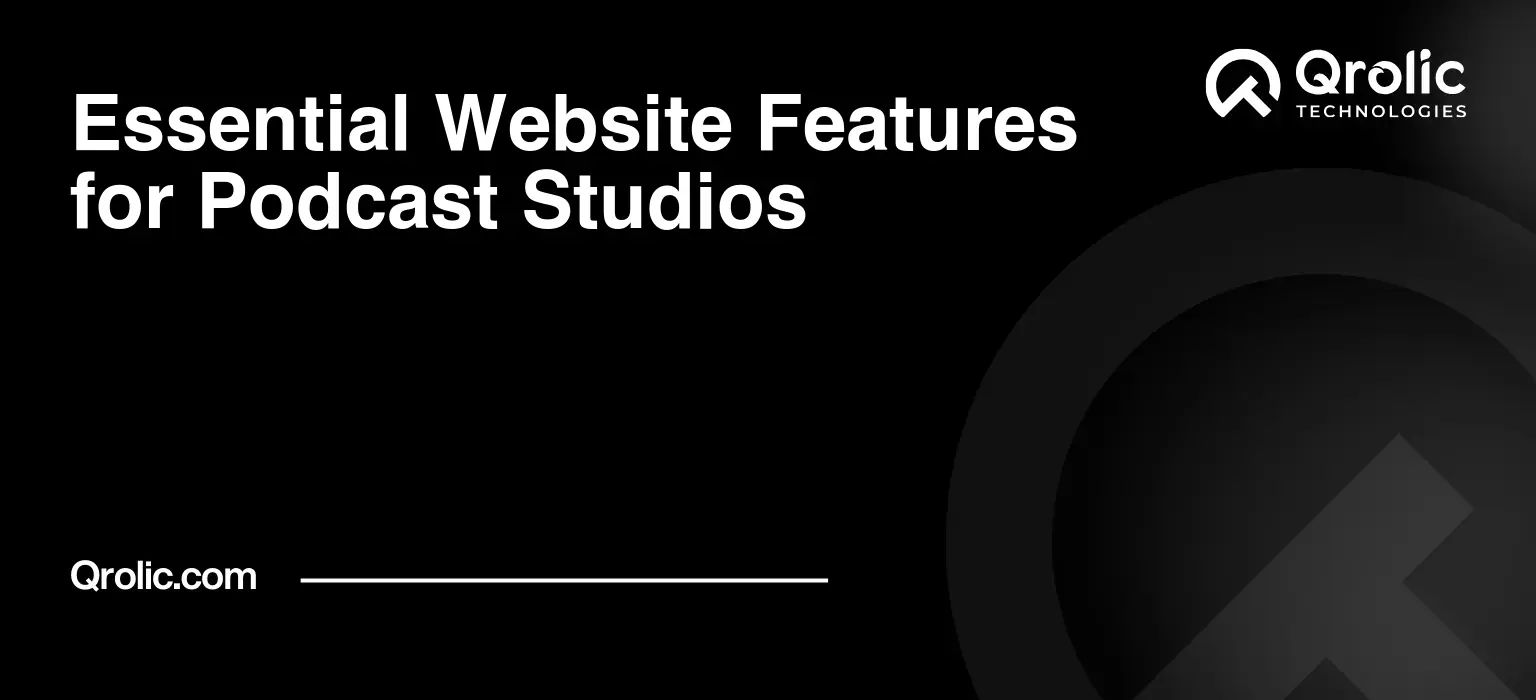Quick Summary:
- A stellar website is vital for network credibility and growth.
- Include clear navigation, quality audio players, and show pages.
- Optimize for search engines, mobile, and potential income.
Table of Contents
- Why Your Podcast Network Needs a Stellar Website
- Establishing Credibility and Professionalism
- Centralizing Your Brand Identity
- Improving Discoverability and SEO
- Generating Leads and Revenue
- Fostering Community Engagement
- Key Elements of Effective Podcast Network Website Design
- Intuitive Navigation and User Experience (UX)
- Clear Menu Structure
- Prominent Search Functionality
- Mobile Responsiveness
- High-Quality Audio Player Integration
- Customizable Player Appearance
- Download Options
- Playback Speed Control
- Compelling Podcast Show Pages
- Engaging Show Descriptions
- Eye-Catching Artwork
- Episode List and Show Notes
- Engaging Visual Content
- Professional Photography
- Custom Graphics and Illustrations
- Video Trailers and Behind-the-Scenes Content
- Effective Call-to-Actions (CTAs)
- Subscribe Buttons
- Email Opt-In Forms
- Purchase Links
- Blog Integration for Content Marketing
- Keyword-Rich Articles
- Guest Interviews
- Behind-the-Scenes Content
- Social Media Integration
- Social Sharing Buttons
- Embedded Social Feeds
- Social Media Promotion
- Fast Loading Speed and Performance
- Image Optimization
- Code Minification
- Content Delivery Network (CDN)
- Audio Web Development Specifics
- Podcast Feed Integration
- RSS Feed Implementation
- Automated Updates
- Audio Playback Optimization
- Streaming Protocols
- Codecs and Encoding
- Cross-Platform Compatibility
- Responsive Design
- Browser Testing
- Media Website Design: Beyond Just Audio
- Video Integration
- Embedded Videos
- Video Galleries
- Interactive Elements
- Quizzes and Polls
- Interactive Transcripts
- Visual Design and Branding
- Consistent Branding
- Professional Layouts
- SEO Optimization: Getting Found in the Crowd
- Keyword Research
- Long-Tail Keywords
- Keyword Placement
- On-Page SEO
- Meta Descriptions
- Header Tags
- Off-Page SEO
- Link Building
- Social Media Promotion
- Technical SEO
- Site Speed
- Mobile-Friendliness
- Monetizing Your Podcast Network Website
- Advertising and Sponsorships
- Banner Ads
- Sponsored Content
- Merchandise Sales
- Online Store
- Affiliate Marketing
- Premium Content and Subscriptions
- Exclusive Episodes
- Behind-the-Scenes Content
- Case Studies: Examples of Successful Podcast Network Websites
- Gimlet Media
- Radiotopia
- Maximum Fun
- The Future of Podcast Network Websites
- Personalization
- Artificial Intelligence (AI)
- Voice Integration
- Qrolic Technologies: Your Partner in Audio Web Development
- Our Services
- Why Choose Qrolic Technologies?
- Final Thoughts: Building a Successful Podcast Network Website
Why Your Podcast Network Needs a Stellar Website
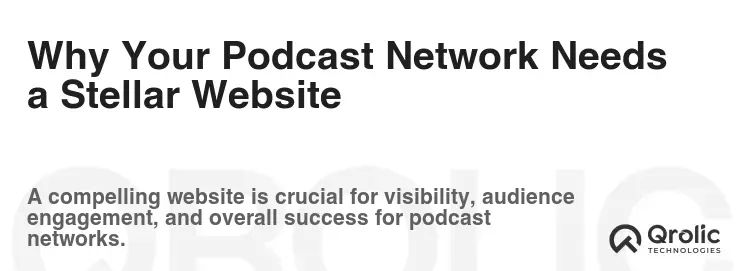
The digital realm is the new broadcasting arena, and your website is your network’s flagship station. It’s not just a digital brochure; it’s the central hub where listeners discover new shows, engage with your brand, and ultimately, become loyal fans. Think of your website as the digital watering hole where your target audience gathers. If the water is murky or hard to access, they’ll move on. But if it’s clear, refreshing, and inviting, they’ll stay and spread the word.
Establishing Credibility and Professionalism
A professionally designed website instantly communicates credibility. In a world saturated with podcasts, standing out requires projecting an image of competence and reliability. Your website is often the first impression potential listeners and sponsors have of your network. A clunky, outdated site screams amateur hour, while a sleek, well-designed site whispers, “We’re serious about podcasting.” It’s about building trust from the very first click. Imagine walking into a beautifully designed studio versus a cluttered basement – which one inspires more confidence?
Centralizing Your Brand Identity
Your website is the digital embodiment of your podcast network’s brand. It’s the place where your logo, color palette, typography, and overall aesthetic converge to create a cohesive and memorable experience. Consistency across all platforms, especially your website, reinforces your brand message and helps listeners recognize and connect with your network. Think of brands like NPR or Gimlet Media – their websites are instantly recognizable and reflect their respective brand identities.
Improving Discoverability and SEO
A well-optimized website significantly improves your network’s discoverability in search engines. By strategically incorporating relevant keywords, crafting compelling meta descriptions, and building a strong internal linking structure, you can climb the search engine rankings and attract organic traffic. This means more potential listeners finding your shows through Google, Bing, and other search engines. It’s like putting up a giant, flashing neon sign on the internet that says, “Podcasts here!”
Generating Leads and Revenue
Your website can be a powerful lead generation tool. By offering valuable content like show notes, transcripts, bonus episodes, and behind-the-scenes glimpses, you can entice visitors to subscribe to your email list. This allows you to nurture leads and promote new shows, merchandise, and other revenue-generating opportunities. Think of it as building a loyal fan base that’s eager to support your network.
Fostering Community Engagement
A website provides a platform for fostering a sense of community among your listeners. By incorporating features like comment sections, forums, and social media integrations, you can encourage interaction and create a space where fans can connect with each other and with your network. A thriving community leads to increased engagement, loyalty, and ultimately, growth.
Key Elements of Effective Podcast Network Website Design
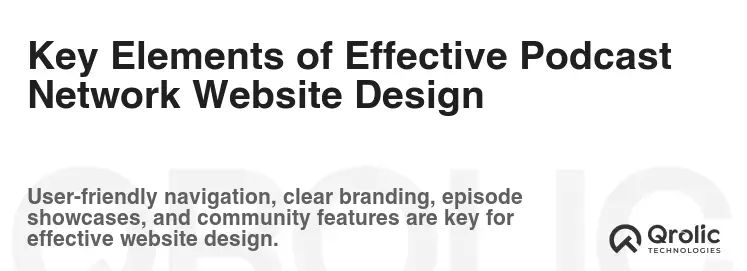
Designing a website for a podcast network requires a strategic approach that considers both user experience (UX) and search engine optimization (SEO). It’s about creating a site that is both visually appealing and highly functional, making it easy for visitors to find what they’re looking for and for search engines to understand what your network is all about.
Intuitive Navigation and User Experience (UX)
Website navigation should be intuitive and user-friendly. Visitors should be able to easily find the information they need, whether it’s a specific podcast, show notes, or contact information. Use clear and concise menus, a logical site structure, and a powerful search function. Think of your website as a well-organized library – visitors should be able to quickly locate the books they’re interested in.
Clear Menu Structure
Organize your menu items into logical categories that reflect the main sections of your website, such as “Podcasts,” “About Us,” “Blog,” and “Contact.” Use descriptive labels that accurately represent the content of each page.
Prominent Search Functionality
Implement a prominent search bar that allows visitors to quickly find specific podcasts, episodes, or keywords. Ensure that the search function is accurate and efficient.
Mobile Responsiveness
In today’s mobile-first world, it’s crucial that your website is fully responsive and adapts seamlessly to different screen sizes. This ensures a positive user experience for visitors on smartphones, tablets, and desktops.
High-Quality Audio Player Integration
The audio player is the heart of your podcast network website. It should be easy to use, visually appealing, and offer features like playback controls, progress bar, and volume adjustment. Consider embedding players from popular podcast hosting platforms like Libsyn, Buzzsprout, or Podbean. Think of your audio player as a finely tuned instrument – it should deliver a smooth and enjoyable listening experience.
Customizable Player Appearance
Choose an audio player that allows you to customize its appearance to match your website’s design. This includes adjusting colors, fonts, and button styles.
Download Options
Provide listeners with the option to download episodes for offline listening. This can be a valuable feature for those who want to listen on the go.
Playback Speed Control
Consider including playback speed control, which allows listeners to speed up or slow down the audio to their preference.
Compelling Podcast Show Pages
Each podcast in your network should have its own dedicated page that showcases the show’s artwork, description, episode list, and embedded audio player. These pages should be designed to entice visitors to listen and subscribe. Think of each show page as a mini-website for that particular podcast.
Engaging Show Descriptions
Craft compelling show descriptions that highlight the podcast’s unique value proposition and target audience. Use strong keywords to improve search engine visibility.
Eye-Catching Artwork
Display high-quality show artwork that is visually appealing and representative of the podcast’s content.
Episode List and Show Notes
Organize episodes in a clear and chronological order. Provide detailed show notes for each episode, including timestamps, guest bios, and links to relevant resources.
Engaging Visual Content
Visual content is essential for capturing attention and keeping visitors engaged. Use high-quality images, videos, and graphics to break up text and enhance the overall user experience. Think of visual content as the seasoning that adds flavor to your website.
Professional Photography
Use professional photography to showcase your podcast hosts, guests, and recording studio.
Custom Graphics and Illustrations
Create custom graphics and illustrations that are unique to your brand and visually appealing.
Video Trailers and Behind-the-Scenes Content
Embed video trailers and behind-the-scenes content to give visitors a glimpse into the making of your podcasts.
Effective Call-to-Actions (CTAs)
Call-to-actions (CTAs) are essential for guiding visitors to take desired actions, such as subscribing to a podcast, joining your email list, or purchasing merchandise. Use clear and concise language, visually appealing buttons, and strategic placement. Think of CTAs as friendly nudges that encourage visitors to take the next step.
Subscribe Buttons
Include prominent “Subscribe” buttons on podcast show pages and throughout your website. Link these buttons to popular podcast listening apps like Apple Podcasts, Spotify, and Google Podcasts.
Email Opt-In Forms
Offer valuable content, such as free guides or bonus episodes, in exchange for visitors’ email addresses. Use attractive opt-in forms that are easy to fill out.
Purchase Links
If you sell merchandise or offer premium content, include clear purchase links on your website.
Blog Integration for Content Marketing
A blog is a valuable tool for content marketing and SEO. Use your blog to publish articles, interviews, and behind-the-scenes content related to your podcasts. This can help you attract new listeners, improve search engine rankings, and establish your network as a thought leader. Think of your blog as a magnet that attracts potential listeners and keeps them coming back for more.
Keyword-Rich Articles
Write keyword-rich articles that target specific topics related to your podcasts.
Guest Interviews
Interview podcast hosts and guests to provide unique insights and perspectives.
Behind-the-Scenes Content
Share behind-the-scenes content, such as recording studio tours and editing tips.
Social Media Integration
Integrate social media platforms to make it easy for visitors to share your podcasts and connect with your network on social media. Use social media sharing buttons, embed social media feeds, and promote your social media channels prominently on your website. Think of social media as a megaphone that amplifies your network’s reach.
Social Sharing Buttons
Include social sharing buttons on podcast show pages and blog posts to encourage visitors to share your content.
Embedded Social Feeds
Embed social media feeds on your website to showcase your latest posts and engage with your audience.
Social Media Promotion
Promote your social media channels prominently on your website to encourage visitors to follow you.
Fast Loading Speed and Performance
Website loading speed is a critical factor for both user experience and SEO. Optimize your website for speed by compressing images, minimizing code, and using a content delivery network (CDN). Think of Website Speed as the engine that drives your online success.
Image Optimization
Compress images to reduce file sizes without sacrificing quality.
Code Minification
Minimize code by removing unnecessary characters and spaces.
Content Delivery Network (CDN)
Use a CDN to distribute your website’s content across multiple servers, which can improve loading speed for visitors around the world.
Audio Web Development Specifics
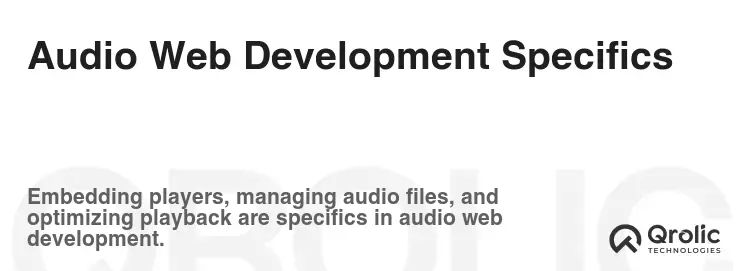
Creating websites for podcast networks demands specific considerations within audio web development. optimizing audio playback, ensuring compatibility across devices, and integrating podcast feeds seamlessly are key aspects.
Podcast Feed Integration
Integrating podcast feeds effectively ensures that your website automatically updates with the latest episodes. Using RSS (Really Simple Syndication) feeds, you can dynamically display new content without manual updates.
RSS Feed Implementation
Implementing RSS feeds involves parsing XML data to extract episode information like titles, descriptions, and audio URLs. Frameworks like React or Vue.js can help in efficiently displaying this data.
Automated Updates
Automated updates are crucial for maintaining a current library. Using server-side scripting or scheduled tasks, you can regularly fetch updates from the RSS feed and refresh the website.
Audio Playback Optimization
Optimizing audio playback ensures a smooth listening experience, crucial for retaining listeners on your site.
Streaming Protocols
Employ streaming protocols like HLS (HTTP Live Streaming) or DASH (Dynamic Adaptive Streaming over HTTP) to adapt to different network conditions, providing uninterrupted playback.
Codecs and Encoding
Selecting the right codecs and encoding parameters ensures high-quality audio without excessively large file sizes. Consider using AAC or MP3 codecs with appropriate bitrates based on the content.
Cross-Platform Compatibility
Ensuring that your audio playback works smoothly across various devices and browsers is critical for reaching a broad audience.
Responsive Design
Responsive design techniques ensure that your website adapts to different screen sizes, providing a consistent experience on desktops, tablets, and smartphones.
Browser Testing
Thoroughly test your website on different browsers like Chrome, Firefox, Safari, and Edge to identify and fix compatibility issues.
Media Website Design: Beyond Just Audio
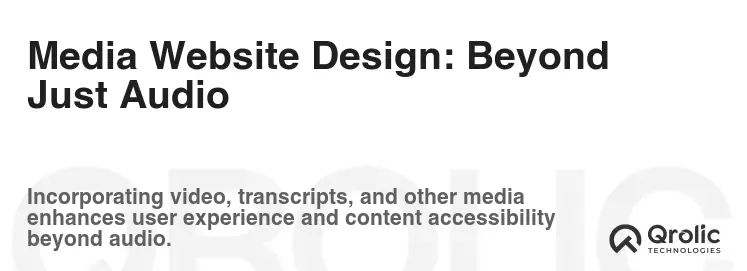
While podcast networks primarily focus on audio content, a successful media website incorporates multimedia elements to enhance user engagement. This includes videos, interactive content, and visually appealing design layouts.
Video Integration
Integrating video content adds another dimension to your website, attracting users who prefer visual media and providing supplementary material related to your podcasts.
Embedded Videos
Embed videos using platforms like YouTube or Vimeo, making sure they are optimized for playback on your website.
Video Galleries
Create video galleries to showcase behind-the-scenes footage, interviews, and promotional content.
Interactive Elements
Interactive elements can greatly enhance user engagement, encouraging visitors to spend more time on your website.
Quizzes and Polls
Implement quizzes and polls related to your podcast content to encourage interaction and gather audience feedback.
Interactive Transcripts
Offer interactive transcripts where users can click on specific sections to jump to that part of the audio, enhancing accessibility and user experience.
Visual Design and Branding
Visual design and branding create a cohesive and appealing look that aligns with your podcast network’s identity.
Consistent Branding
Maintain a consistent brand identity across all visual elements, including logos, color schemes, and typography.
Professional Layouts
Use professional layout designs that are both visually appealing and easy to navigate.
SEO Optimization: Getting Found in the Crowd
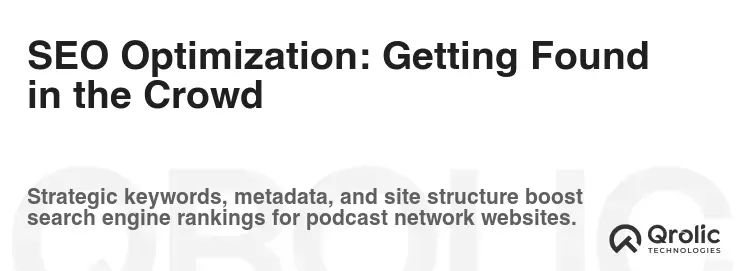
Search Engine Optimization (SEO) is vital for ensuring that your podcast network’s website ranks high in search engine results, driving organic traffic and increasing visibility.
Keyword Research
Conduct thorough keyword research to identify terms that your target audience is searching for. Use tools like Google Keyword Planner or SEMrush to find relevant keywords.
Long-Tail Keywords
Focus on long-tail keywords, which are longer and more specific phrases that can attract highly targeted traffic.
Keyword Placement
Strategically place keywords in your website’s titles, descriptions, headings, and content to improve search engine rankings.
On-Page SEO
On-page SEO involves optimizing elements within your website to improve search engine visibility.
Meta Descriptions
Write compelling meta descriptions for each page, encouraging users to click through from search engine results.
Header Tags
Use header tags (H1, H2, H3) to structure your content and highlight important keywords.
Off-Page SEO
Off-page SEO involves building your website’s authority through external links and mentions.
Link Building
Build high-quality backlinks from reputable websites to improve your site’s credibility.
Social Media Promotion
Promote your website and podcasts on social media to increase visibility and attract more traffic.
Technical SEO
Technical SEO ensures that your website is technically sound and easy for search engines to crawl and index.
Site Speed
Optimize your website for speed to improve user experience and search engine rankings.
Mobile-Friendliness
Ensure that your website is mobile-friendly, as Google prioritizes mobile-first indexing.
Monetizing Your Podcast Network Website
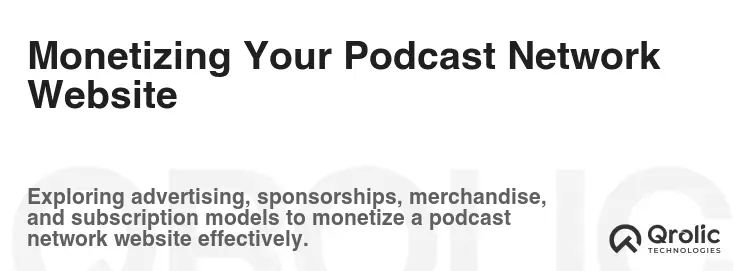
A well-designed website can be a powerful tool for monetizing your podcast network through various strategies.
Advertising and Sponsorships
Advertising and sponsorships can generate revenue by displaying ads or featuring sponsors on your website.
Banner Ads
Display banner ads in strategic locations on your website, such as the header, sidebar, or footer.
Sponsored Content
Create sponsored content, such as blog posts or podcast episodes, that promote a sponsor’s products or services.
Merchandise Sales
Selling merchandise related to your podcasts can generate revenue and build brand loyalty.
Online Store
Set up an online store on your website to sell merchandise like t-shirts, mugs, and stickers.
Affiliate Marketing
Promote other companies’ products or services and earn a commission on sales generated through your affiliate links.
Premium Content and Subscriptions
Offering premium content and subscriptions can provide a recurring revenue stream.
Exclusive Episodes
Offer exclusive podcast episodes to subscribers as a premium benefit.
Behind-the-Scenes Content
Provide behind-the-scenes content and bonus materials to subscribers.
Case Studies: Examples of Successful Podcast Network Websites

Analyzing successful podcast network websites can provide valuable insights and inspiration for your own design.
Gimlet Media
Gimlet Media’s website is known for its clean design, intuitive navigation, and engaging content. They offer detailed show pages, high-quality audio players, and a seamless user experience.
Radiotopia
Radiotopia’s website showcases a diverse range of podcasts with a visually appealing layout and easy-to-use navigation. They emphasize community engagement and offer a variety of ways for listeners to connect with the network.
Maximum Fun
Maximum Fun’s website features a vibrant and playful design that reflects the network’s personality. They offer a wide range of podcasts and have a strong focus on community support through membership programs.
The Future of Podcast Network Websites

The future of podcast network websites will likely involve greater personalization, interactivity, and integration with emerging technologies.
Personalization
Personalized content recommendations and user experiences will become more common, tailoring the website to individual listener preferences.
Artificial Intelligence (AI)
AI-powered tools may be used to generate content, improve search functionality, and provide personalized recommendations.
Voice Integration
Voice integration could allow users to interact with the website and listen to podcasts using voice commands.
Qrolic Technologies: Your Partner in Audio Web Development

Qrolic Technologies (https://qrolic.com/) specializes in creating cutting-edge websites for podcast networks. We offer a range of services, including audio web development, media website design, and SEO optimization. Our team of experienced developers and designers can help you create a website that not only looks great but also drives results.
Our Services
- Audio Web Development: We provide custom audio web development solutions, including podcast feed integration, audio player optimization, and cross-platform compatibility.
- Media Website Design: Our media website design services focus on creating visually appealing and user-friendly websites that showcase your podcast network’s brand.
- SEO Optimization: We offer comprehensive SEO optimization services to improve your website’s search engine rankings and drive organic traffic.
Why Choose Qrolic Technologies?
- Expertise: Our team has extensive experience in audio web development and media website design.
- Custom Solutions: We provide custom solutions tailored to your specific needs and requirements.
- Results-Driven: We are committed to delivering results that help you grow your podcast network.
- Client Satisfaction: We prioritize client satisfaction and work closely with you throughout the development process.
Final Thoughts: Building a Successful Podcast Network Website
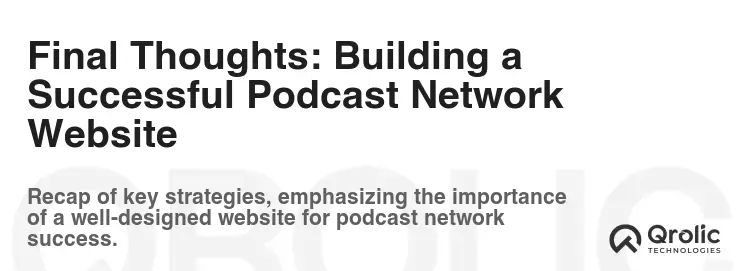
Creating a successful website for your podcast network requires careful planning, strategic design, and ongoing optimization. By focusing on user experience, SEO, and monetization strategies, you can create a website that attracts new listeners, engages your audience, and generates revenue. Remember, your website is the digital home of your podcast network, and it should be designed to welcome and delight your visitors.
